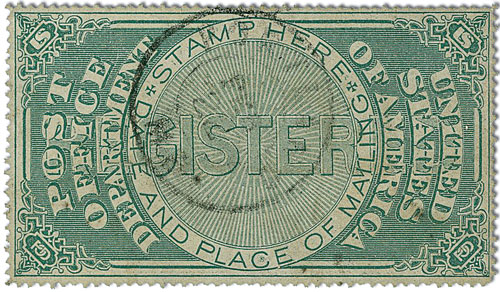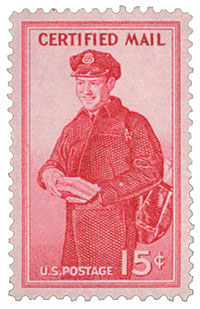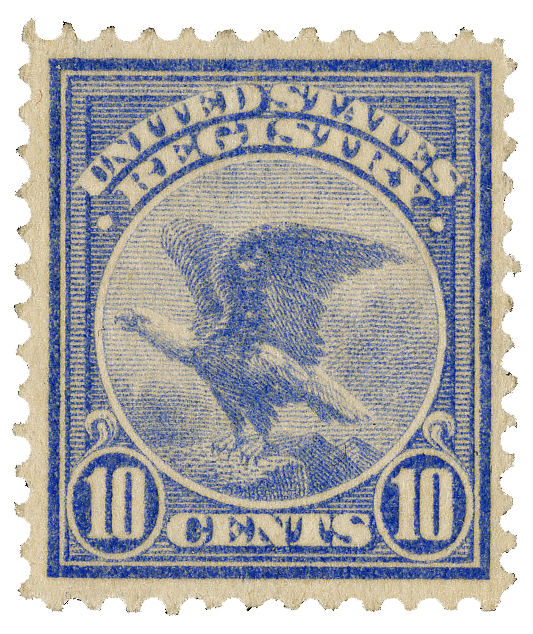
# OXF1 - 1872 Registry Seal - green, white wove paper, perf 12
Own Seal Used by Postal Employees
This 145-year-old Registry Seal was placed over the flap of a large envelope containing registered letters to prevent tampering. Used by Post Office employees, it's one of the largest U.S. stamps issued.
First And Only U.S. Registration Stamp
The U.S. first implemented a registered letter system on July 1, 1855. For the next 56 years, mailers could pay the registration fee, which ranged from five to twenty cents over these years, with cash or stamps.
Though there wasn’t a Registered Mail stamp issued during this time, there were Post Office Seals, also known as Official Seals. They had no franking power, meaning they didn’t pay for the delivery of mail, but they did serve an important purpose. The first official seals had one specific role: to seal large “registered packages” containing registered letters that were being transported, thereby preventing tampering with this very secure class of mail.

Then on December 1, 1911, the Post Office issued U.S. #F1, America’s first and only registration stamp for the prepayment of registry fees. This new stamp could only be used to pay the registry fee and was not valid for regular postage. When used in addition to regular postage, this stamp provided special care and handling for an extra fee for a letter or package. Upon receiving the item, the addressee was required to sign a receipt.
There was some confusion among users and postal clerks around these stamps, which led to their misuse. As a result, the Postmaster General abolished the Registration stamp in 1913, but allowed the remaining stock to be used up. After that, the registration fee could be paid by using regular postage stamps.

A similar stamp was issued in 1955. The 15¢ Certified Mail stamp, #FA1. Certified Mail is a form of registration – it gives mail special protection and provides the sender with proof of delivery. A single stamp was issued June 6, 1955, to inaugurate the Certified Mail Service. This was used in addition to the regular postage and required the recipient to sign for his letter or package upon delivery.
Own Seal Used by Postal Employees
This 145-year-old Registry Seal was placed over the flap of a large envelope containing registered letters to prevent tampering. Used by Post Office employees, it's one of the largest U.S. stamps issued.
First And Only U.S. Registration Stamp
The U.S. first implemented a registered letter system on July 1, 1855. For the next 56 years, mailers could pay the registration fee, which ranged from five to twenty cents over these years, with cash or stamps.
Though there wasn’t a Registered Mail stamp issued during this time, there were Post Office Seals, also known as Official Seals. They had no franking power, meaning they didn’t pay for the delivery of mail, but they did serve an important purpose. The first official seals had one specific role: to seal large “registered packages” containing registered letters that were being transported, thereby preventing tampering with this very secure class of mail.

Then on December 1, 1911, the Post Office issued U.S. #F1, America’s first and only registration stamp for the prepayment of registry fees. This new stamp could only be used to pay the registry fee and was not valid for regular postage. When used in addition to regular postage, this stamp provided special care and handling for an extra fee for a letter or package. Upon receiving the item, the addressee was required to sign a receipt.
There was some confusion among users and postal clerks around these stamps, which led to their misuse. As a result, the Postmaster General abolished the Registration stamp in 1913, but allowed the remaining stock to be used up. After that, the registration fee could be paid by using regular postage stamps.

A similar stamp was issued in 1955. The 15¢ Certified Mail stamp, #FA1. Certified Mail is a form of registration – it gives mail special protection and provides the sender with proof of delivery. A single stamp was issued June 6, 1955, to inaugurate the Certified Mail Service. This was used in addition to the regular postage and required the recipient to sign for his letter or package upon delivery.












